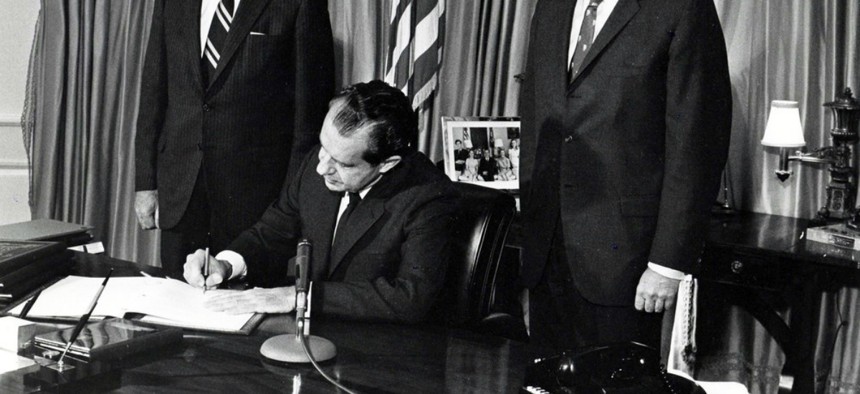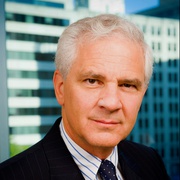
President Richard Nixon signs the Treaty on the Non-Proliferation of Nuclear Weapons, or NPT. Nixon Foundation
Happy 50th Birthday to the NPT Nuclear Treaty
There’s good reason to celebrate the Non-Proliferation Treaty of 1968. We’re all still here, aren’t we? But the NPT regime's protections are being tested more profoundly than ever.
President John F. Kennedy worried about a world with dozens of nuclear-armed states “large and small, stable and unstable, responsible and irresponsible.” To prevent small wars from becoming nuclear wars, he launched a suite of security initiatives including negotiating a limited nuclear test ban treaty and establishing an agency devoted solely to arms control and disarmament. But none were as consequential as his hope for a treaty to prevent the spread of these weapons.
Kennedy died before the process began in earnest, but Lyndon Johnson picked up where JFK left off. He told Secretary of State Dean Rusk to “get me a treaty” and Rusk did. On July 1, 1968, LBJ signed the diplomatic crown jewel of his presidency: the Treaty on the Non-Proliferation of Nuclear Weapons, popularly known as the Non-Proliferation Treaty, or NPT.
Nixon later secured the NPT’s Senate ratification and proclaimed its entry into force with a flourish in March 1970. “Let us trust that we will look back,” he said, “and say that this was one of the first and major steps in that process in which the nations of the world moved from a period of confrontation to a period of negotiation and a period of lasting peace.” The treaty went into effect with almost 100 nations as original signatories.
Fifty years on, its failures are clear. The world has not eliminated its nuclear weapons, several new states have obtained them, and we are a long way from “lasting peace.” But the treaty and the regime it spawned are the major reasons that so few nations have nuclear weapons today. The NPT has helped keep the nuclear peace — an achievement too many credit to the existence of the weapons themselves rather than the web of treaties, controls, norms, and security pacts that restrain their spread, inhibit their development, and condemn their use.
In this highly-polarized moment, the treaty is also a reminder of the power of bipartisanship. Liberals and conservatives, Republicans and Democrats labored together on the NPT. The process was inspired by Eisenhower, initiated by Kennedy, and championed by Johnson. Presidents Nixon, Reagan, Bush, and Clinton performed much of the diplomatic heavy lifting, negotiating and implementing nearly all of the treaties and arrangements we know as the nonproliferation regime, banning or restricting nuclear, chemical and biological weapons.
But the regime is being tested today more profoundly than at any time in its history. Arms reductions have stopped and every nuclear-armed state is now building new nuclear weapons. With President Donald Trump’s abandonment of the JCPOA accord blocking Iran’s paths to a bomb, a new wave of proliferation could threaten the Middle East. If his faith-based approach to North Korea fails, the same could be true in East Asia. One bright spot could be an agreement between President Vladimir Putin and Trump at their July summit to extend the New START treaty past its 2021 expiration date. But many fear the concessions Trump might make to the Russian leader (such as recognizing the annexation of Crimea) could undermine the global order upon which the NPT is based.
The treaty is a central pillar of the international security system, with almost every nation in the world a member. The basic pact is simple: 186 nations pledge never to acquire nuclear weapons; the five nuclear-armed states recognized by the treaty (the United States, Russia, the United Kingdom, France, and China) commit to reduce and eventually eliminate their arsenals; those states with nuclear technology promise to sell it as long as nations pledge to use only it for peaceful purposes. Four nuclear-armed states stand outside the treaty: Israel, India, Pakistan and North Korea.
“The first and greatest success of the NPT is that only these nine countries are believed to have nuclear weapons,” wrote the U.S. negotiator for the treaty, Ambassador George Bunn, in 2004. “Without the NPT, I believe that 30-40 countries would now have nuclear weapons.”
Since its signing, many more countries have given up nuclear weapon programs than have begun them. This would include not just “rogue states” like Libya, Iraq, and South Africa, but many of our allies “large and small” who were exploring nuclear weapons programs before the treaty, including Argentina, Australia, Brazil, Japan, South Korea, Sweden, and West Germany. Similarly, global powers reduced their nuclear arsenals by 80 percent from nearly 65,000 at the height of the Cold War to the 14,465 nuclear weapons remaining today — progress cited repeatedly by those states as evidence of their fulfillment of the terms of the NPT.
The treaty did not emerge in a diplomatic vacuum. It reflected the political-military balance of power and alliance systems of the late 20th century. The U.S. and the Soviet Union helped ensure its quick adoption and provided security guarantees for those countries abandoning the nuclear option. But the treaty regime survived and strengthened after the Cold War ended. The nuclear test ban treaty cited in the NPT’s preamble was finally signed in 1996.
The treaty regime embodies what the G7 members meant when they insisted over Trump’s objections on keeping in their recent communiqué a “commitment to promote a rules-based international order.” The NPT established both the international legal mechanism and the global diplomatic norm that gave nations a clear path to a non-nuclear future. It captured rather than created the consensus view developing within many nations that their security was better assured without nuclear weapons than with them.
In today’s debates between regime change models and diplomacy, the NPT is testament to the efficacy of the diplomatic path. It offers a successful example of the security provided by a web of agreements enforced by the collective political will of the participants. Indeed, violations of the treaty prove its utility. The sanctions applied to both North Korea and Iran are made possible under international law because those nations violated their NPT obligations. (North Korea withdrew from the NPT but is considered bound by its restrictions.)
This enterprise is taking a lot longer than Kennedy had hoped. We are still, as he said, “struggling to escape from the darkening prospect of mass destruction on earth.” It has not been quick, but neither are we dead. The NPT is a major reason why. And for that, we should all celebrate its birthday.




